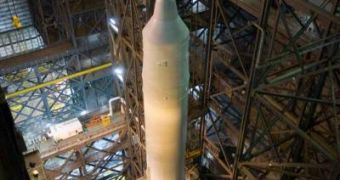The American space agency NASA is proud to inform that it has successfully finished building the first fully functional rocket of its new ARES I series, known as ARES I-X. The spacecraft is part of the agency's Project Constellation, and is designed to become a replacement for the aging space shuttles, which are due to be retired out of active service by the end of next year. Scheduled to perform its first flight test later this fall, the new rocket has the ability to take astronauts to low-Earth orbit, and also to farther destinations, such as the Moon, and potentially Mars, Space reports.
For more than 25 years, NASA has preferred using existing technologies, and has not been engaged in developing new lines of boosters. But its efforts of augmenting existing ones also became increasingly difficult from a certain point forward, and so a total rethinking of its approach to space exploration was needed. The ARES I will only be certified as representing the new way to do things if it manages to successfully carry and deliver the Orion Crew Exploration Vehicle, another Constellation component, to Earth's orbit and beyond.
“More than three years of hard work with the NASA and contractor team has brought us to this historic moment. This flight test is a critical step in continuing our design process for the Ares vehicle and the first flight for the Constellation program,” the NASA ARES I-X mission manager, Bob Ess, said in a statement. “If the loads testing goes well, then we should be able to make the Oct. 31st target,” ASA spokesperson Allard Beutel adds. On this date, the first flight test with the new rocket is scheduled to take place.
The new rocket has a height of 327 feet (100 meters), which makes it the biggest booster in the large Vehicle Assembly Building (VAB), at the Kennedy Space Center, in Cape Canaveral, Florida. It is significantly taller than the Saturn 1B rockets, which were used by American astronauts on their way to the Skylab space station, and several tens of feet higher than shuttle-carrying rockets. When completed the ARES V heavy-lift delivery system will be even taller, but also wider, and able to carry several tons to whichever destination it's sent to.

 14 DAY TRIAL //
14 DAY TRIAL //